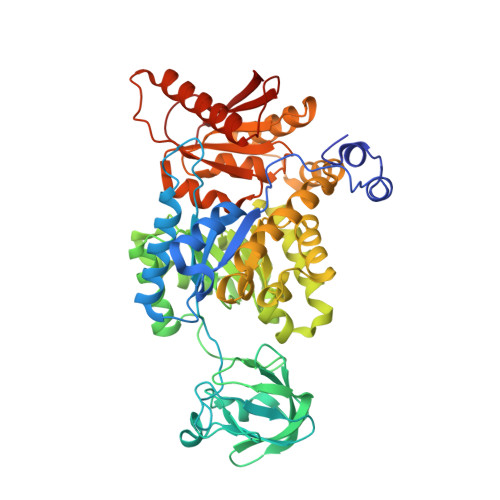Structure and Function of Human Erythrocyte Pyruvate Kinase. Molecular Basis of Nonspherocytic Hemolytic Anemia.
Valentini, G., Chiarelli, L.R., Fortin, R., Dolzan, M., Galizzi, A., Abraham, D.J., Wang, C., Bianchi, P., Zanella, A., Mattevi, A.(2002) J Biological Chem 277: 23807
- PubMed: 11960989
- DOI: https://doi.org/10.1074/jbc.M202107200
- Primary Citation of Related Structures:
2VGB, 2VGF, 2VGG, 2VGI - PubMed Abstract:
Deficiency of human erythrocyte isozyme (RPK) is, together with glucose-6-phosphate dehydrogenase deficiency, the most common cause of the nonspherocytic hemolytic anemia. To provide a molecular framework to the disease, we have solved the 2.7 A resolution crystal structure of human RPK in complex with fructose 1,6-bisphosphate, the allosteric activator, and phosphoglycolate, a substrate analogue, and we have functionally and structurally characterized eight mutants (G332S, G364D, T384M, D390N, R479H, R486W, R504L, and R532W) found in RPK-deficient patients. The mutations target distinct regions of RPK structure, including domain interfaces and catalytic and allosteric sites. The mutations affect to a different extent thermostability, catalytic efficiency, and regulatory properties. These studies are the first to correlate the clinical symptoms with the molecular properties of the mutant enzymes. Mutations greatly impairing thermostability and/or activity are associated with severe anemia. Some mutant proteins exhibit moderate changes in the kinetic parameters, which are sufficient to cause mild to severe anemia, underlining the crucial role of RPK for erythrocyte metabolism. Prediction of the effects of mutations is difficult because there is no relation between the nature and location of the replaced amino acid and the type of molecular perturbation. Characterization of mutant proteins may serve as a valuable tool to assist with diagnosis and genetic counseling.
- Dipartimento di Genetica e Microbiologia, Università di Pavia, via Abbiategrasso 207, 27100 Pavia, Italy. giovale@unipv.it
Organizational Affiliation:




















